
Table of Contents
As Jewelry Shopping Guide editors, we write about things that we love and we think you’ll like too. We often have affiliate partnerships, and may generate some revenue from these links at no cost to you.
Hoop earrings often go in and out of style, but they continue to be one of the most recognizable and beloved types of jewelry. They’re one of the oldest accessories in human history and have been worn in many ancient cultures.
What’s fascinating about hoop earrings is how their meaning and symbolism has changed in various cultures throughout history. They’ve been worn as symbols of royalty, nobility, power, unity, philosophy and even femininity, to name a few.
All this translates to the popularity and love for hoop earrings today so let’s have a look at their history and how they’ve evolved over the centuries.
The History of Hoop Earrings
Hoop earrings have been worn in almost every ancient human society including Egyptians, African tribes, Greeks, Romans, most East Asian cultures and Mesoamericans. In fact, they were used millennia before the invention of the written word so it’s difficult to pinpoint where they originated and were first used.
The Western Origin of Hoop Earrings
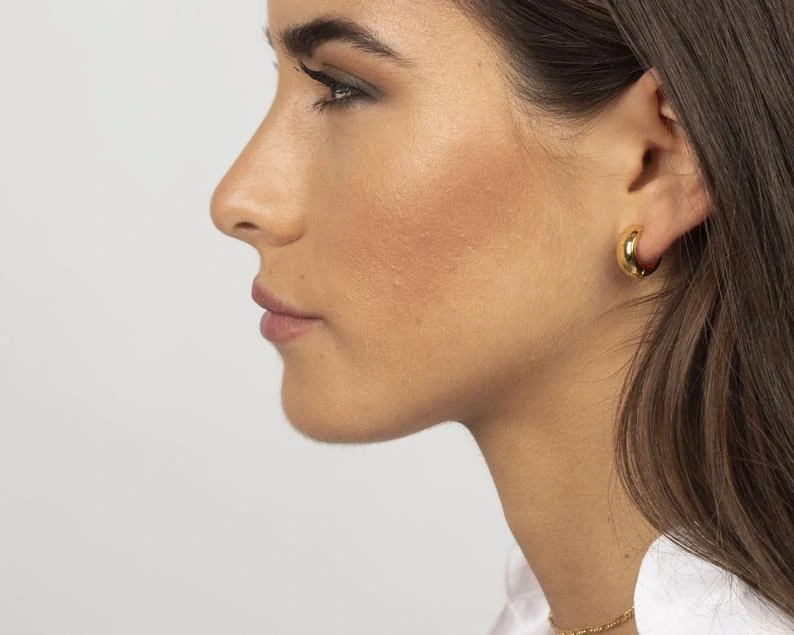
Archaeological evidence has shown that the first Western culture to start using hoop earrings is the North-African Nubian civilization (modern-day Sudan) some 4,500 years ago (around 2,500 BCE). Archaeologists have unearthed Nubian jewelry including hoop earrings made in various metals such as bronze, silver and gold.
According to the evidence, it seems that the Nubian civilization used hoop earrings for aesthetic purposes and not as a particular status symbol, although hoops were generally viewed as symbols of eternity around that time. While, like today, expensive jewelry was mostly owned by those who ranked higher in the social hierarchy, the hoop earring design itself was used all across Nubian society.
It’s possible that other Western cultures used hoop earrings around the same time although no archaeological evidence has been found yet to prove this. However, the consensus at the moment is that the Nubians were the first to invent this accessory, eventually sharing the practice with the Egyptians and other Mediterranean cultures some 1,000 years later (around 1,500 BCE).
Hoop Earrings in Ancient Egypt and Across the Mediterranean
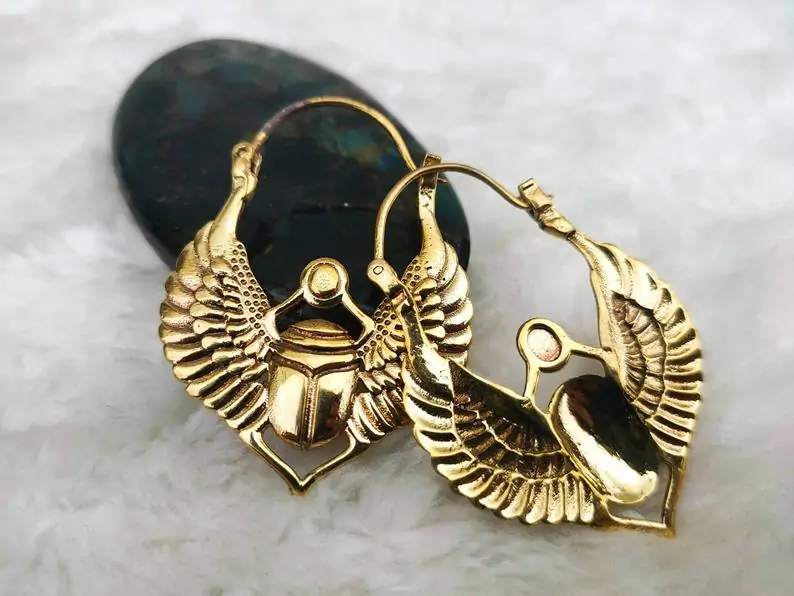
The hoop earring design became extremely popular in all Egyptian kingdoms throughout history, among both royalty and commoners alike. Egyptian men and women wore wear large, gorgeous hoops on their ears made of any available jewelry material but predominantly out of twisted gold or beads.
Naturally, the hoops of the Royal Egyptian families were made of heavy, thick gold and included a lot of religious imagery as well as symbolism to showcase their wealth and power.
As a more powerful and expansive civilization than the Nubians, the ancient Egyptians brought the hoop earring style with them across the Mediterranean and the Middle East. Greeks and Romans quickly adopted the practice of wearing them although they restricted it mostly to women.
Some men with high social status still wore hoop earrings as a hierarchical symbol but jewelry was worn mostly by women in Greco-Roman cultures. This was because the Greco-Roman men saw men of other ‘barbarian’ cultures wearing hoops and they rejected the practice as ‘barbaric’ or ‘foreign’.
In ancient Persia, on the other hand, men wore hoop earrings just like women. Soldiers even wore them into battle. However, they usually wore one small earring on just one ear and left the other ear “naked”.
The Asian Origin of Hoop Earrings
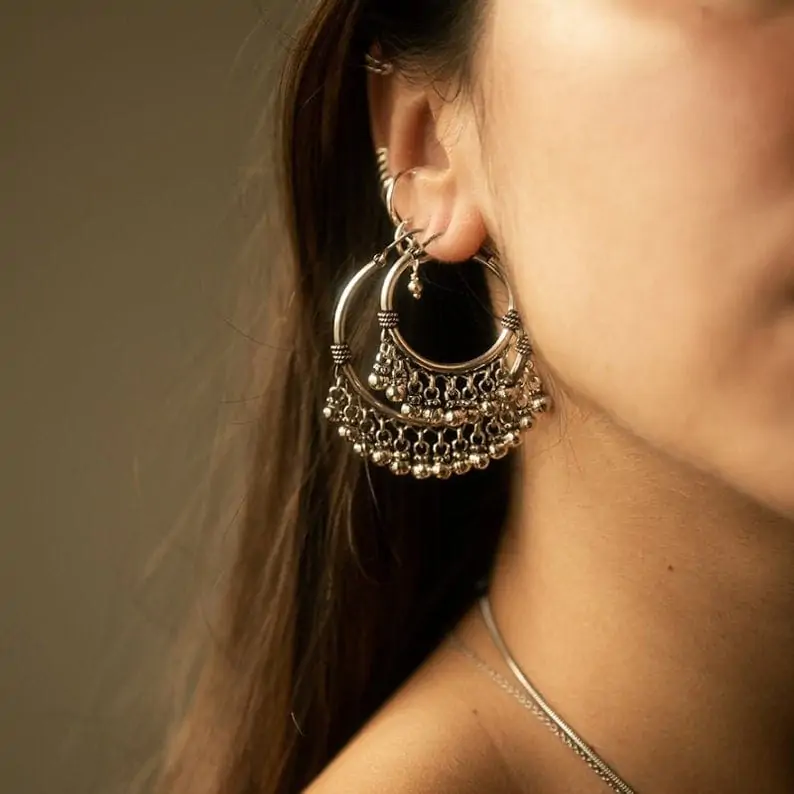
While the Nubians and Egyptians made hoop earrings popular in Northern Africa, Europe and the Middle East, it’s believed that they were worn by the East Asians long before this period. There is plenty of archeological evidence of jade hoop earrings in Southwest and Northeast Asia dating as far back as 5,000 BCE. That’s over 7,000 years ago!
Indian cultures seem to have used hoop earrings even before they became popular in the Western world, as there are many depictions of Hindu gods as well as the Buddha wearing hoop earrings.
Furthermore, in most Asian cultures, hoop earrings were seen not just as fashion accessories but as a means of warding off evil spirits. Their hoops were also much bulkier than those in the west, with many additional ornaments and pendants attached to each hoop.
Romani Hoop Earrings
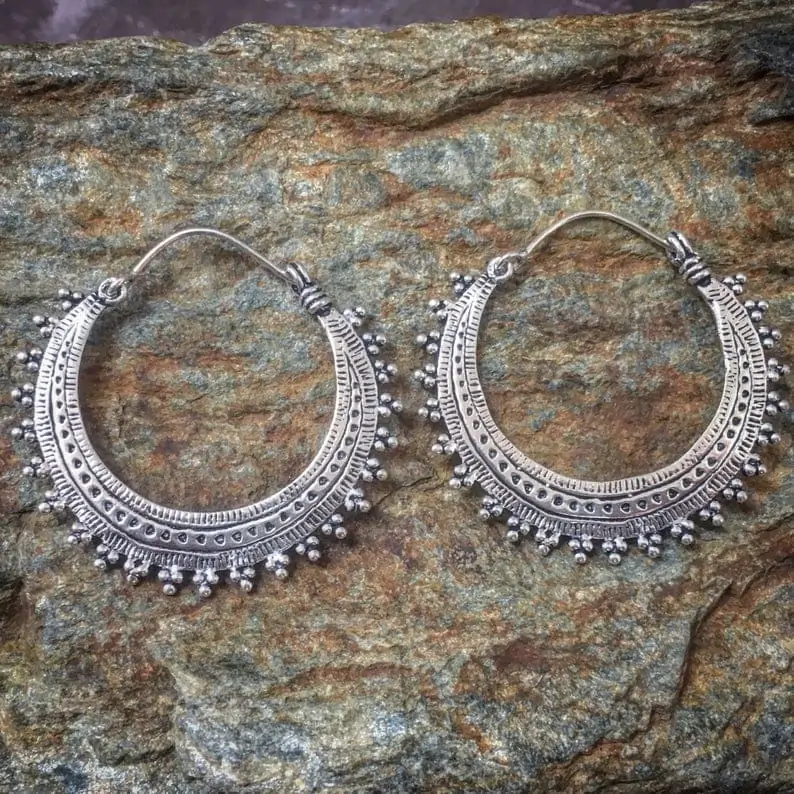
The Romani culture is a unique and fascinating example of the historic and cultural power of hoop earrings. Known as “gypsy” in the US and Western Europe or “tsingani” meaning “untouchables” in Greek, the Romani culture actually comes from the Punjab region of Northern India. The Romani people were often mistaken for Egyptians because of their brown skin color and their love for hoop earrings.
One of the most historically persecuted ethnic minorities, the Romani people continued to use hoop earrings that they brought with them from India in much the same way they’ve held on to other cultural accessories and traditions.
Similar to Indian hoop earrings, Romani hoops are often very rich, large, and adorned with multiple ornaments. Hoops are closely associated with their culture and heritage which is why they hold this accessory very dear.
Hoop Earrings in Europe’s Dark Ages
The popularity of hoop earrings and jewelry as a whole declined across Europe in the Dark Ages for multiple reasons. For one, resource scarcity meant that only the royalty and aristocracy had access to precious metals and gemstones so not everyone could afford jewelry. However, the few earrings that were more affordable and made of less costly metals were simple yet looked stunning at the same time
During that time, jewelry was equated to vanity or wealth, which were considered sins in the Judeo-Christian moral framework that was popular. Due to this, people turned away from jewelry. However, that didn’t stop religious leaders or the aristocracy from wearing various types of jewelry, including hoop earrings.
Hoop Earrings in the Early European Modern Age
In Europe back in the 1600s, the use of jewelry began to decline since fashion had begun to shift more toward elaborate hairstyles, headpieces, and ear-covering clothing. Then, in the 1700s, earrings were back in style but smaller, pear-shaped pearl designs were more popular than hoops. That’s both because hoops were seen as “archaic” and not as luxurious as pearl and gemstone earrings.
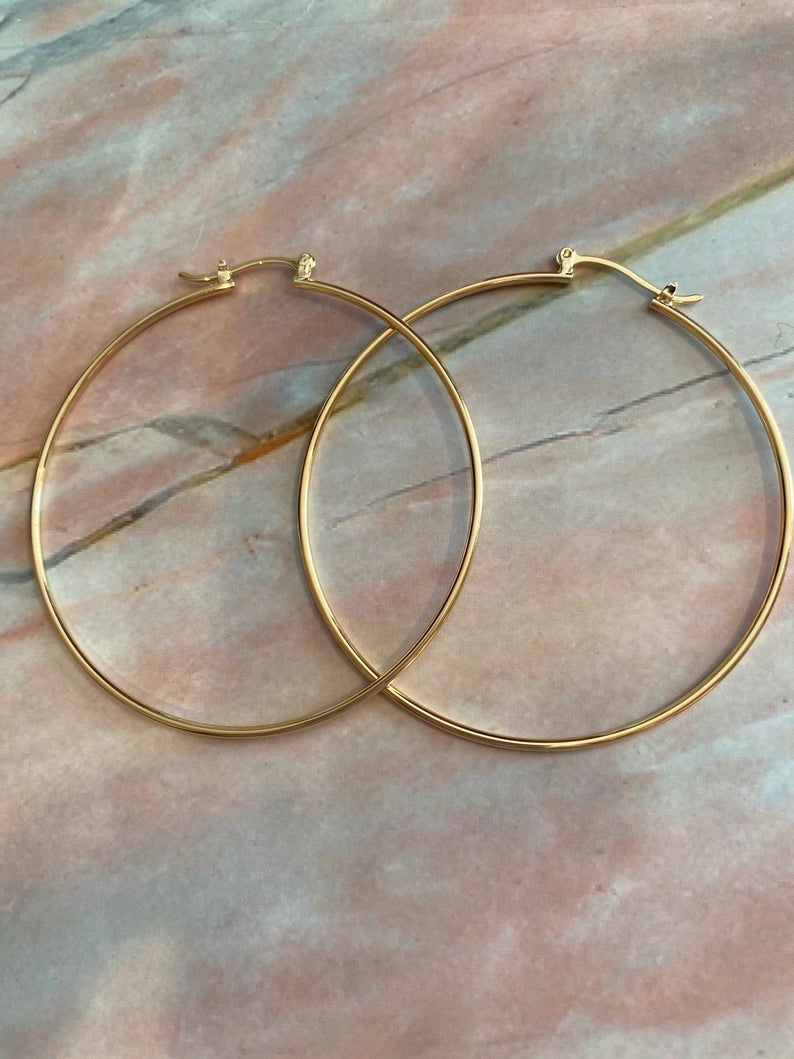
The 1800s saw a rise in the popularity of light hoop earrings compared to heavy pearl or pendant earrings because they didn’t weigh as much and felt more comfortable. Ancient Roman culture was coming back into fashion as well so even larger golden hoops were becoming popular once again.
Hoop Earrings in Latino Culture
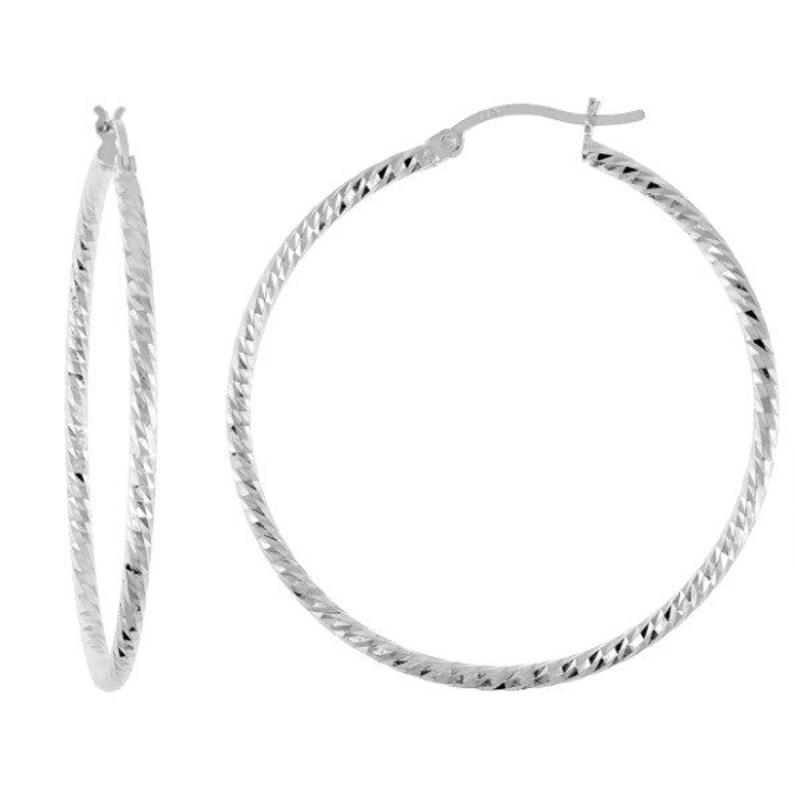
The hooped earring design has been popular in most Latino cultures ever since its inception. There are many fascinating factors that play into that.
For one, the native Mesoamerican and South American cultures loved all types of earrings. Hoop earrings didn’t seem as popular back then simply because people at the time focused on even larger and more luxurious earpieces such as large gold disks or even globe earrings. Large hoop earrings are viewed by modern Latino cultures as a connection with their Native American ancestors.
Hooped earrings were also brought from Europe and linked modern-day Latinos to their Hispanic ancestors as well. They’re also viewed as symbols of their immigrant heritage and a connection to the Old World. It’s common for Latinas to inherit hoop earrings that belonged to their mothers and grandmothers as treasured heirloom jewelry.
Hoop Earrings in the 20th Century West and Beyond
Hoop earrings were popular in the early 20th century U.S. because people at the time associated them with the Native American and Latino cultures. In fact, a lot of white American women at the time stopped wearing earrings altogether since that type of jewelry was seen as “oriental” and they didn’t want to be seen wearing the fashion of the immigrants.
The 1920s did see a resurgence of earring use, however, both thanks to the movie industry and the general change in fashion trends. Hoop earrings, in particular, became increasingly popular as people warmed up toward the exotic Egyptian and Spanish styles. The discovery of King Tutankhamen’s tomb in 1922 was an especially big part of that switch.
Hoop earrings continued to be popular in both the U.S. and Europe during the latter half of the century since the newer metals and materials used made them even lighter and more comfortable. Thanks to celebrities such as Cher and Diana Ross, they were further popularized in the 70s and 80s.
In the 1990s and 2000s, hoop earrings began to be associated with Latino culture again as well as with hip hop. With both being extremely popular to this day, the hoop earring design is still very much in style.
There is some debate that wearing hoop earrings is cultural appropriation, as it’s a piece of jewelry representing certain minorities and their resistance and strength.
Meaning and Symbolism of Hoop Earrings
Throughout history, hoop earrings have carried different meanings and symbolism in various cultures around the world.
For most ethnic cultures today, they’re representations of their heritage and history.
As they’re mostly a woman’s accessory, they also represent femininity and female strength.
Over the years, however, hoop earrings have also been symbols of Royal power and authority, of the aristocracy, as well as of religious faith and protection against evil spirits.
They are also seen as symbols of Latin culture and heritage.
They’re also viewed as just stylish and classy fashion accessories.
Wrapping Up
Today, hoop earrings continue to be a staple in various cultures as well as a popular fashion accessory. Now that you know their vast history, you’ll be able to flaunt your pair of dazzling hoops proudly as a symbol of your independence. While they’re mostly worn as a fashion accessory, hoop earrings remain a very important part of cultural tradition as well as identity.









